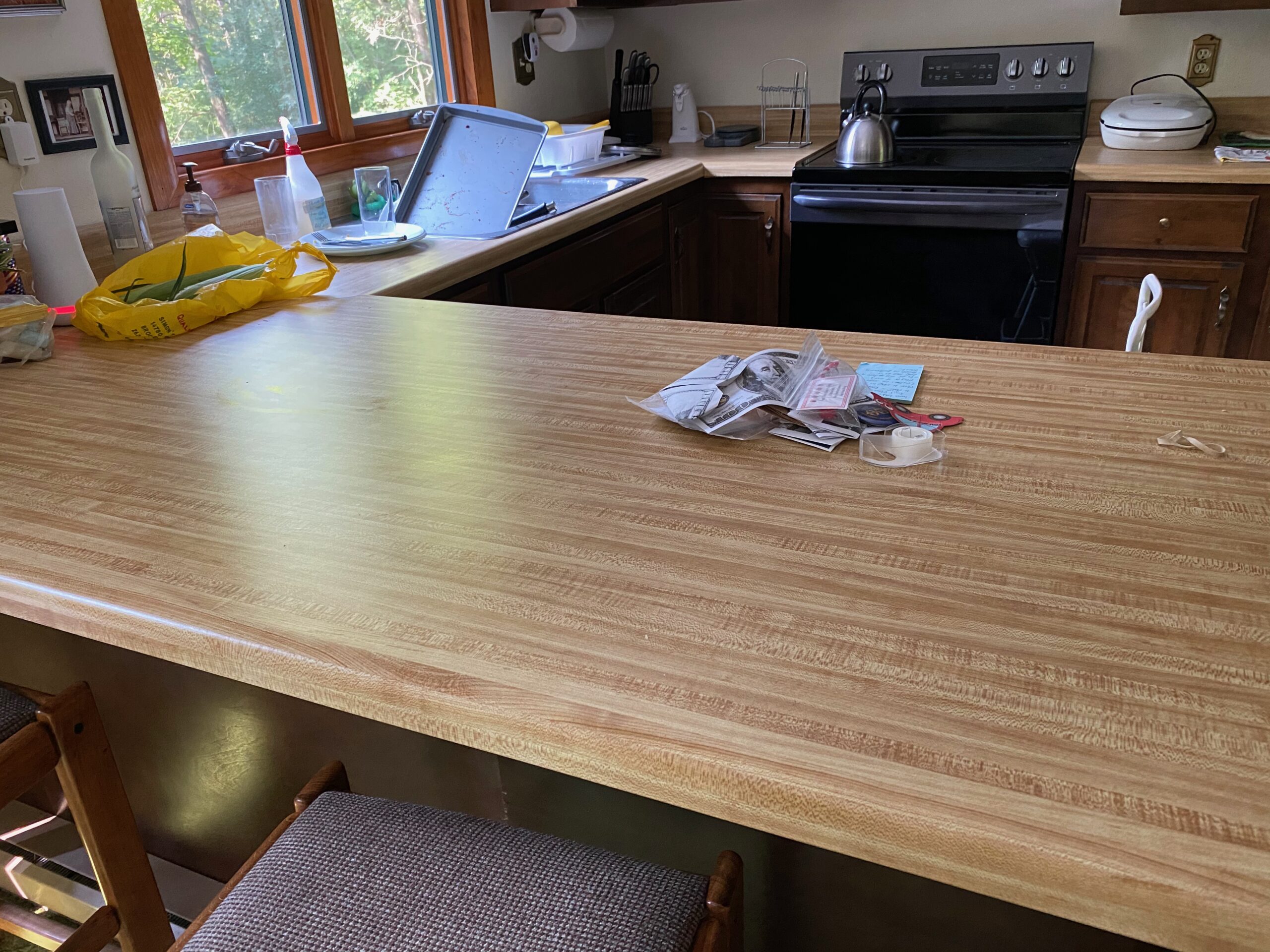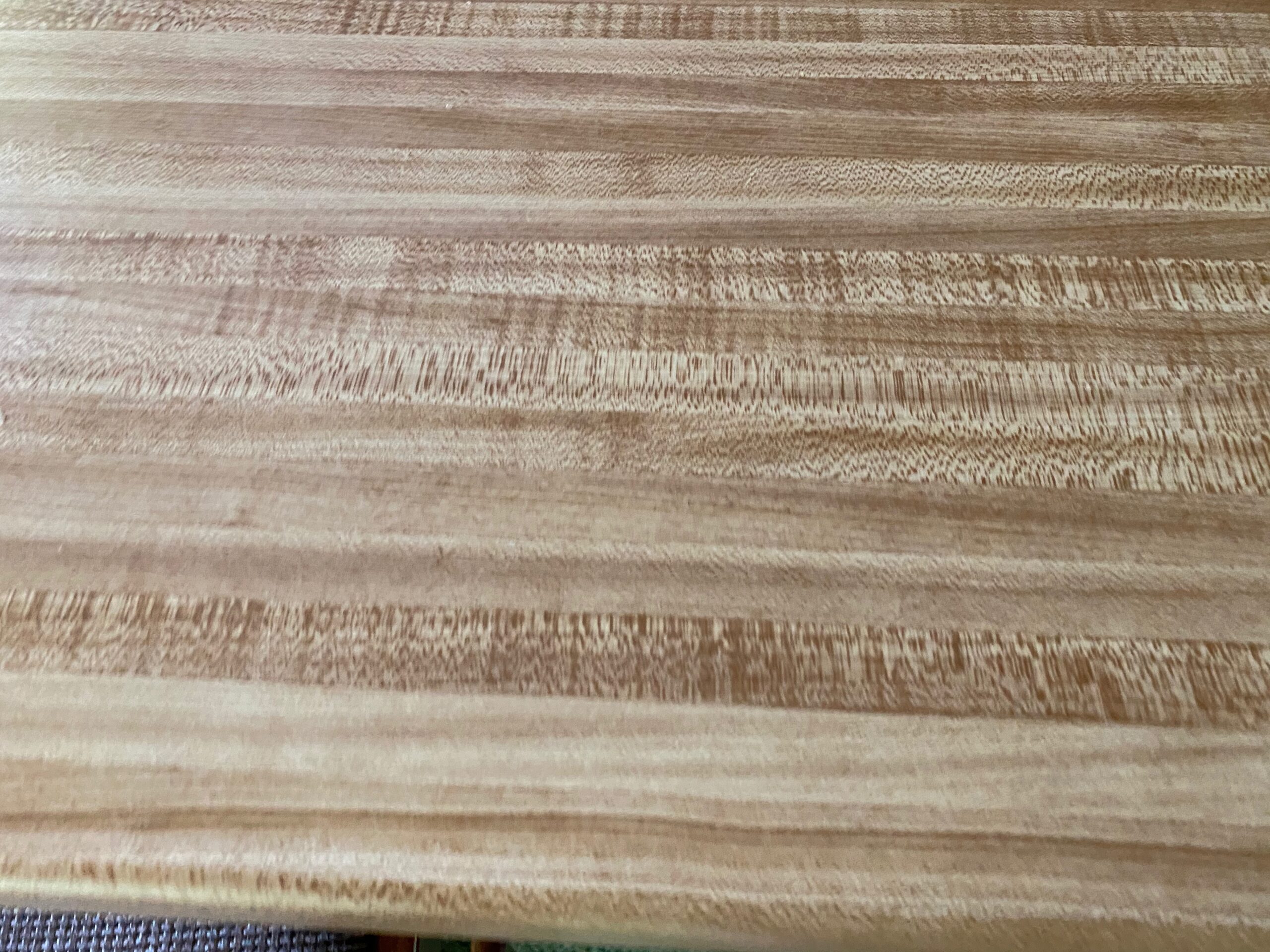Do you (or your grandma) have kitchen counters like this? If so they may test positive for unsafe levels of Lead.

Vintage (1970s / 1980s) faux wood vinyl countertops often have unsafe levels of Lead.
When I walk in to a home and see counters like these now – based on experience – I am almost always certain that they will test positive for Lead. This particular counter was likely from the year the home was built – about 1981 – but in most similar cases I have not been able to discern a precise year of manufacture for the counter. I believe it would be accurate to say that the similar vinyl (both faux wood-pattern and solid colors) counters that I have found to test positive for Lead were manufactured between 1970 and 1990.
What were the exact XRF test results for the counter pictured?
- Lead (Pb): 574 +/- 37 ppm
- Cadmium (Cd): 70 +/- 8 ppm
- Mercury (Hg): Non-Detect
- Barium (Ba): Non-Detect
- Chromium (Cr): Non-Detect
- Antimony (Sb): Non-Detect
- Selenium (Se): Non-Detect
- Silver (Ag): 13 +/- 5 ppm
How much Lead is “too much” Lead?
Newly-manufactured items made today are considered unsafe for children to use if they are finished with any paint or coating that is 90 ppm Lead or higher. [Substrates that test positive for 100 ppm Lead (or higher) are considered unsafe for children.] When Lead-based paint was banned in 1978, the requirement was that paint for residential use must henceforth contain less than 600 ppm Lead — however, that level was subsequently lowered, and now modern house paint must be below 90 ppm Lead [and is usually negative for Lead].
While there is no regulatory standard limiting Lead content in products intended for use by adults, ALL regulatory agencies agree that “there is no safe level of Lead exposure“. Any amount of Lead exposure is considered harmful, and should be avoided.
As adults today (in the modern world), we should work towards eliminating all known and all potential sources of exposure to Lead – because it is the aggregate exposure from all potential sources that is likely to cause long-term harm [it is not necessarily that one particular product might be a specific source of Lead-poisoning for you or for your family — although this has been known to happen with some food-use products (or non-food-use products if ingested)].
“Is this a ‘real’ concern? I have counters like these! What should I do?“
I think the answer to this question is contingent on several factors; most import: what is the state of wear of the surface of the counter? If the counter has significant wear (all over, or only in specific areas) either from normal use or from abrasive cleansers (or other abrasion), it could present a health hazard. I would also be concerned if the owner/user was using the surface to prepare any acidic foods – which might potentially leach Lead from the surface (tomatoes, lemons or other acidic fruits or foods placed directly on the surface during food prep activities could become contaminated with micro-particles of Lead.) Finally I would have concerns if a young person (like a baby or toddler) was eating food directly off the counter (as so many children do).
I personally would not be comfortable preparing food on counters like these (especially on a regular basis). This is primarily due to the fact that the potential health impact of having Leaded vinyl counter tops has not – to my knowledge – ever been studied, and I prefer to err on the side of caution.
The solution (to making this area safe for food prep) is also fairly simple and inexpensive – so I would definitely consider implementing a simple solution if you have counters like this and do not yet have funds to have them replaced.
“So Tamara – what’s the solution?”
The solution is so simple and so inexpensive (at least the “temporary” solution!): cutting boards! In home consultations with clients, if I ever have any concerns for Lead in kitchen counters (in vinyl countertops, ceramic tile, or otherwise) I always suggest getting several cutting boards to use as surfaces instead of the surface of the counter itself. I personally prefer natural untreated wood cutting boards, but the new / modern various plastic ones are also generally Lead-free. Here are some good examples of cutting boards that should be Lead-free:
- a plastic option: https://amzn.to/2QZl9v7
- a wooden option: https://amzn.to/3bwhmPj
- I purchased one of these earlier this year: https://amzn.to/3jV1Srj
As always, please let me know if you have any questions and I will do my best to answer them personally. Thank you for taking the time to read and share my posts.
Tamara Rubin
#LeadSafeMama
Amazon links are affiliate links. If you purchase something after clicking on one of my links I may receive a small percentage of what you spend at no extra cost to you.
Never Miss an Important Article Again!
Join our Email List




AFM safecoat brand sells several types of sealants that can be used on top of off gassing and other types of products. You can seal carpets, countertops, tiles, furniture, etc. Good luck!
I personally would never use a coating on a kitchen counter.
Even if it is AFM safecoat? The countertop has to be glued together since the slabs do not come in the sizes that are needed. There is no glue that is strong enough that is more nontoxic that will hold well. We have a store where they carry only these safer products and said they don’t feel anything is strong enough. so since they have to use a strong glue which will off-gas, they suggested using AFM sealant to protect us from the off-gassing. Any further thoughts? So appreciate it! Thank you!
what about new (last ten years) “formica” laminate type counter tops? are they the same?
No – those are generally Lead-free.
T
I have a house feom 1970 with he original counters…also very 70s! White with sort of green and grey marble look design throughout. They have cut marks all over (not from me). I’m guessing I shouldn’t be kneading dough on this then?
And I remember those wood counters! My grandma had them!